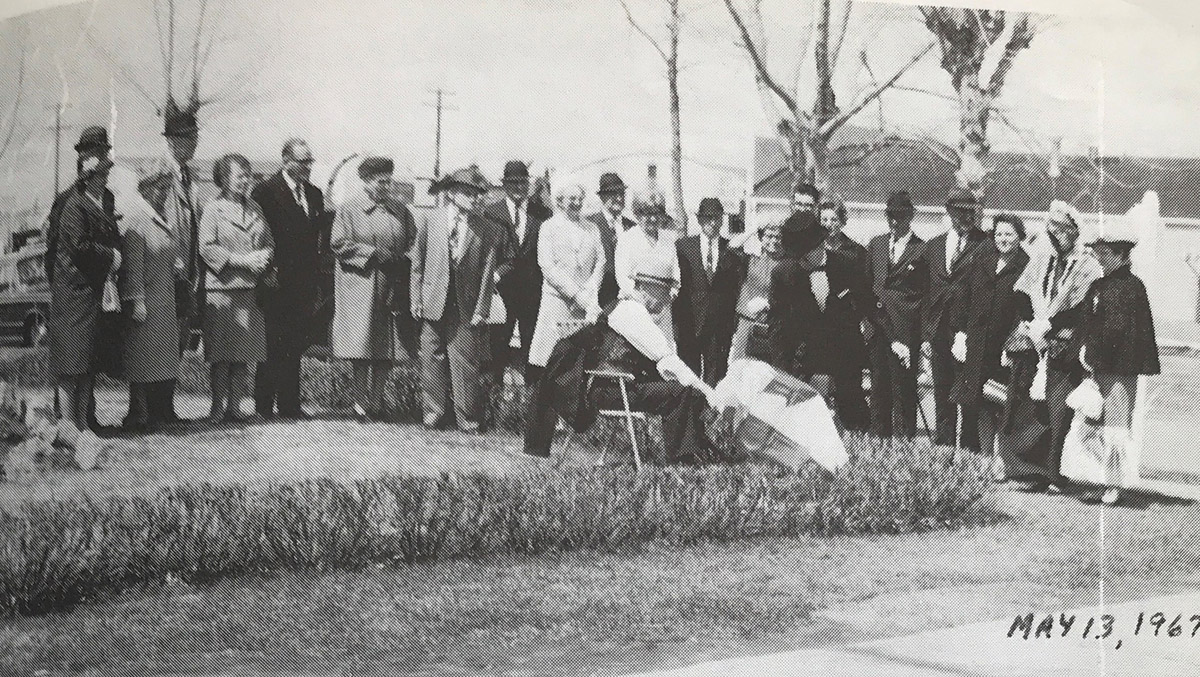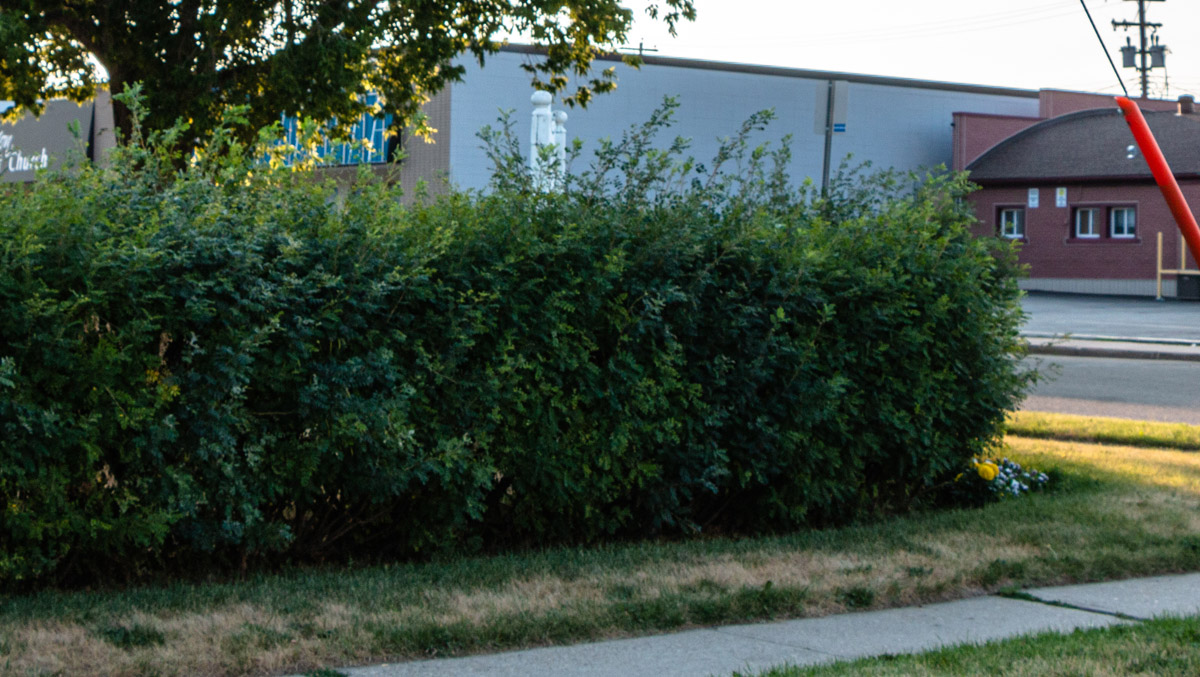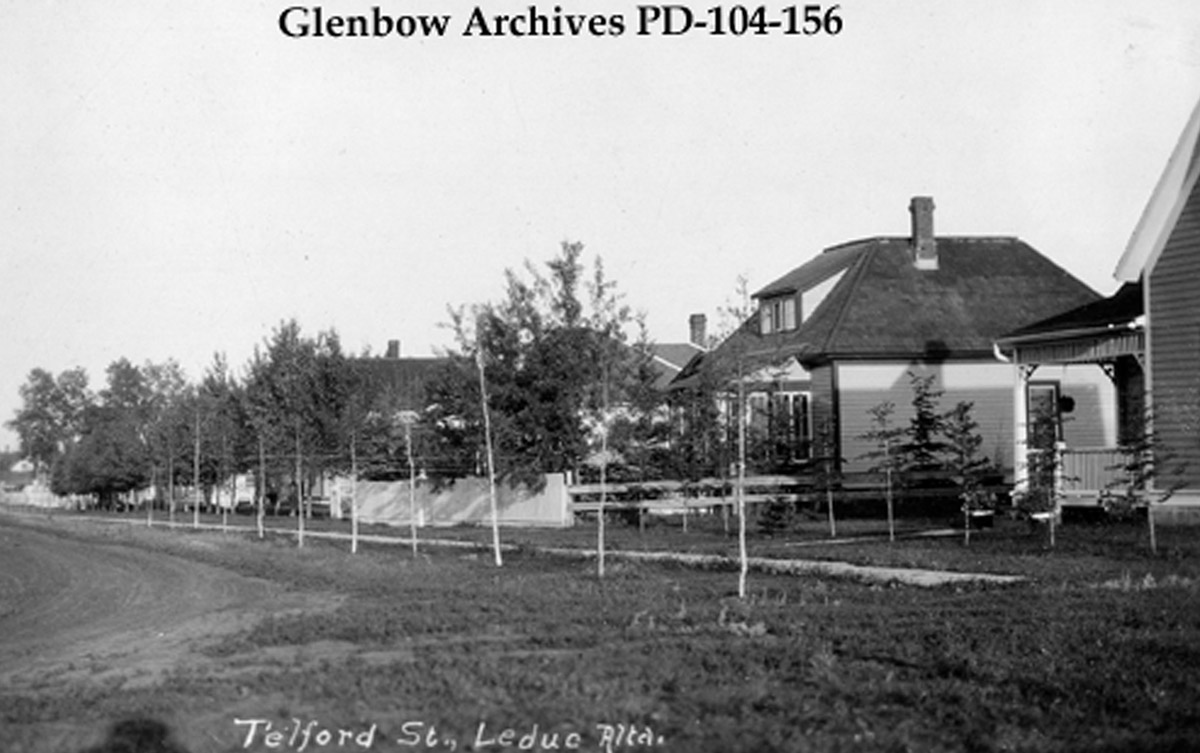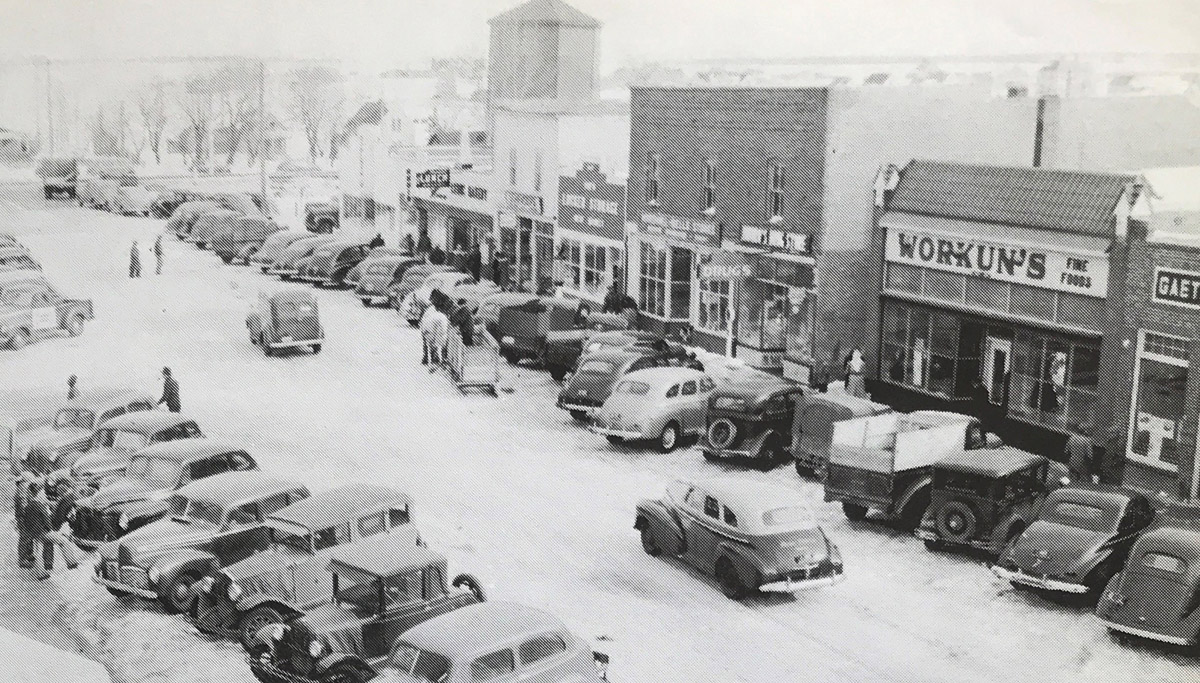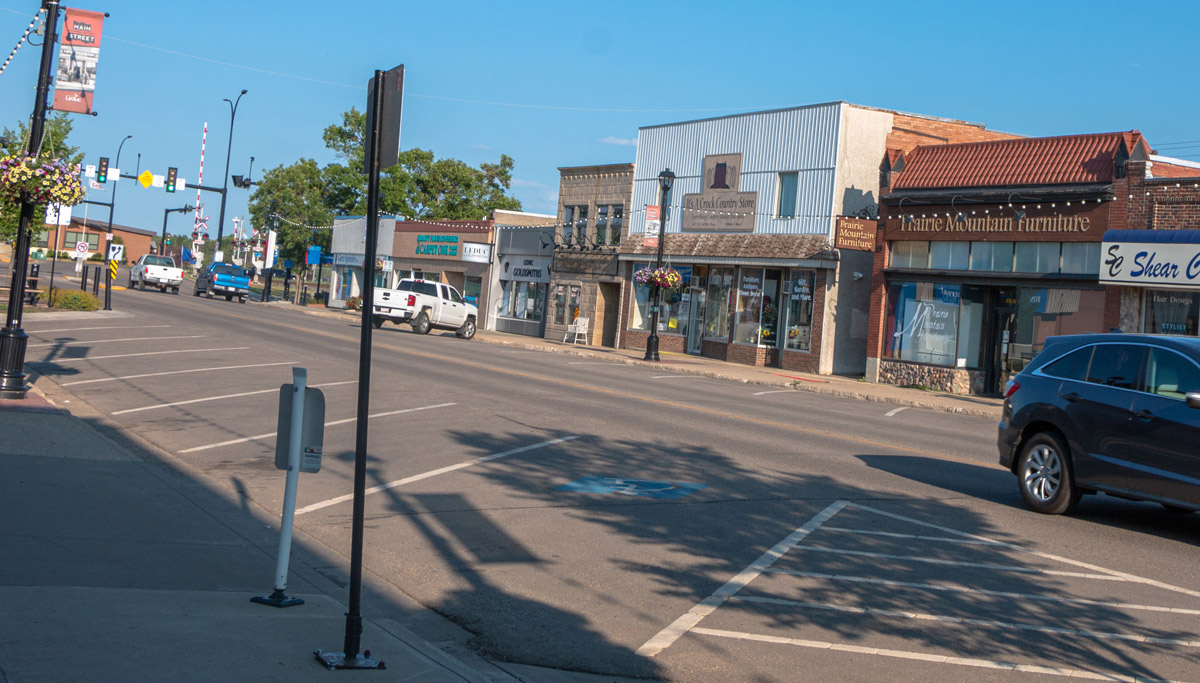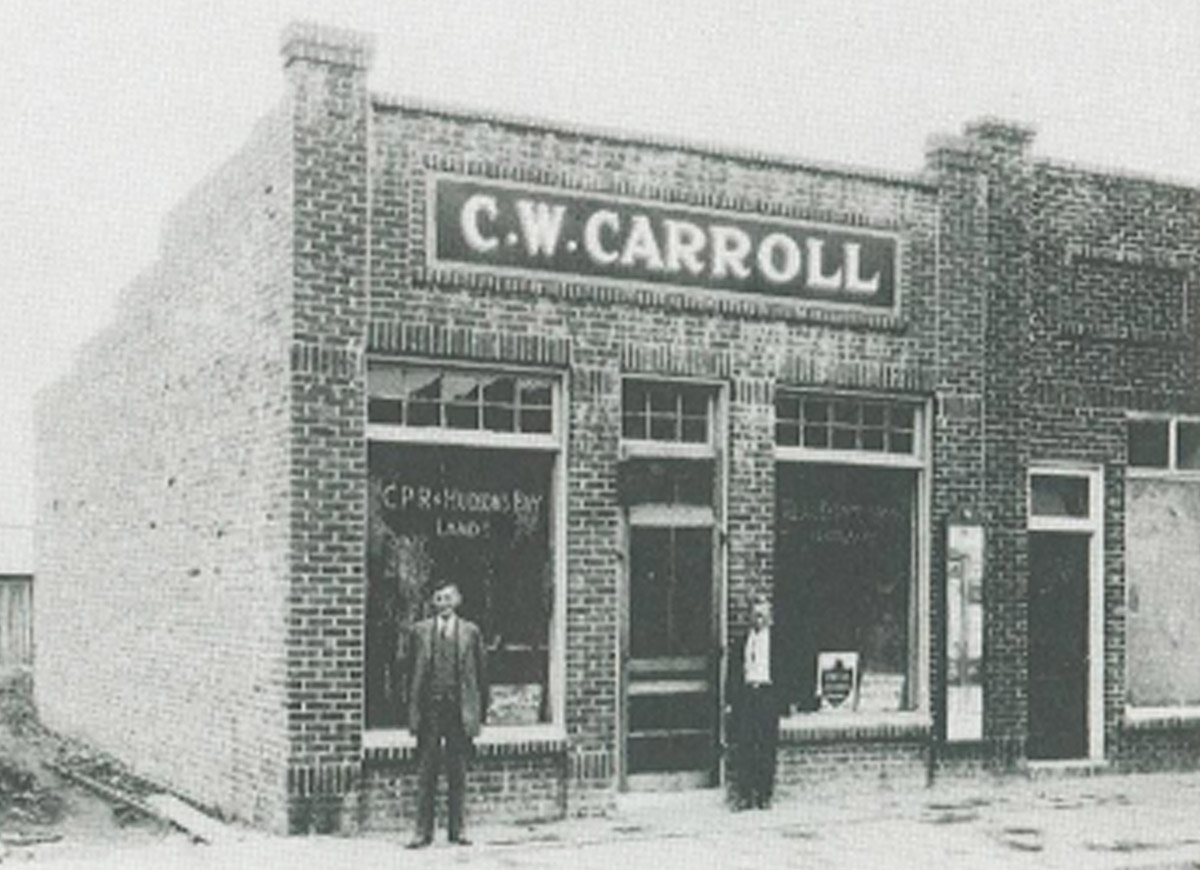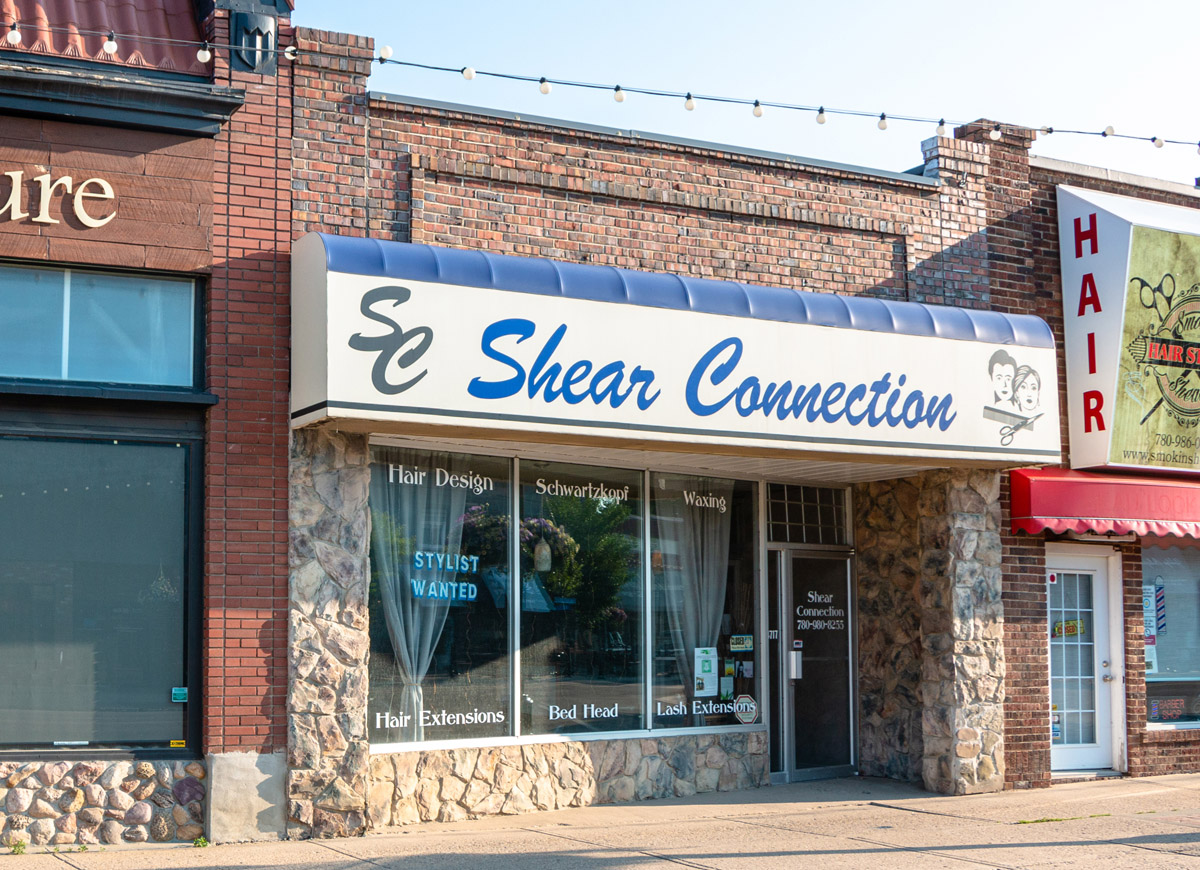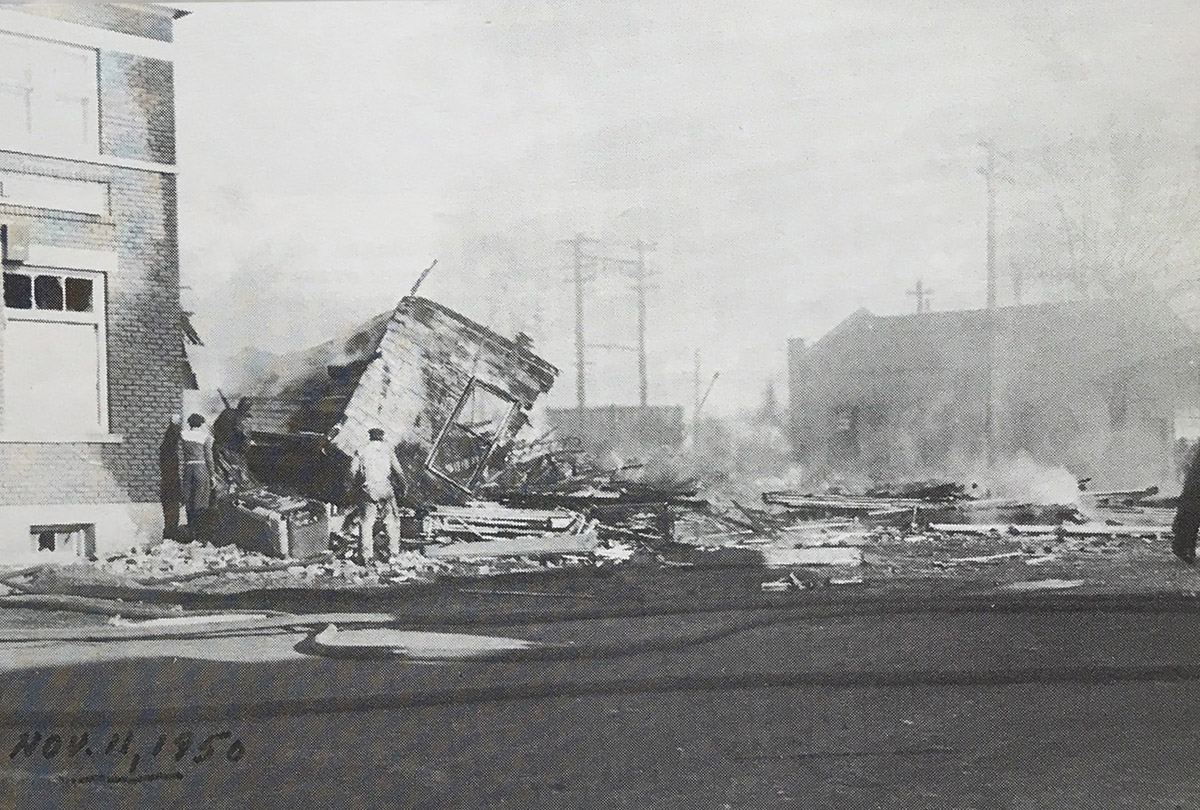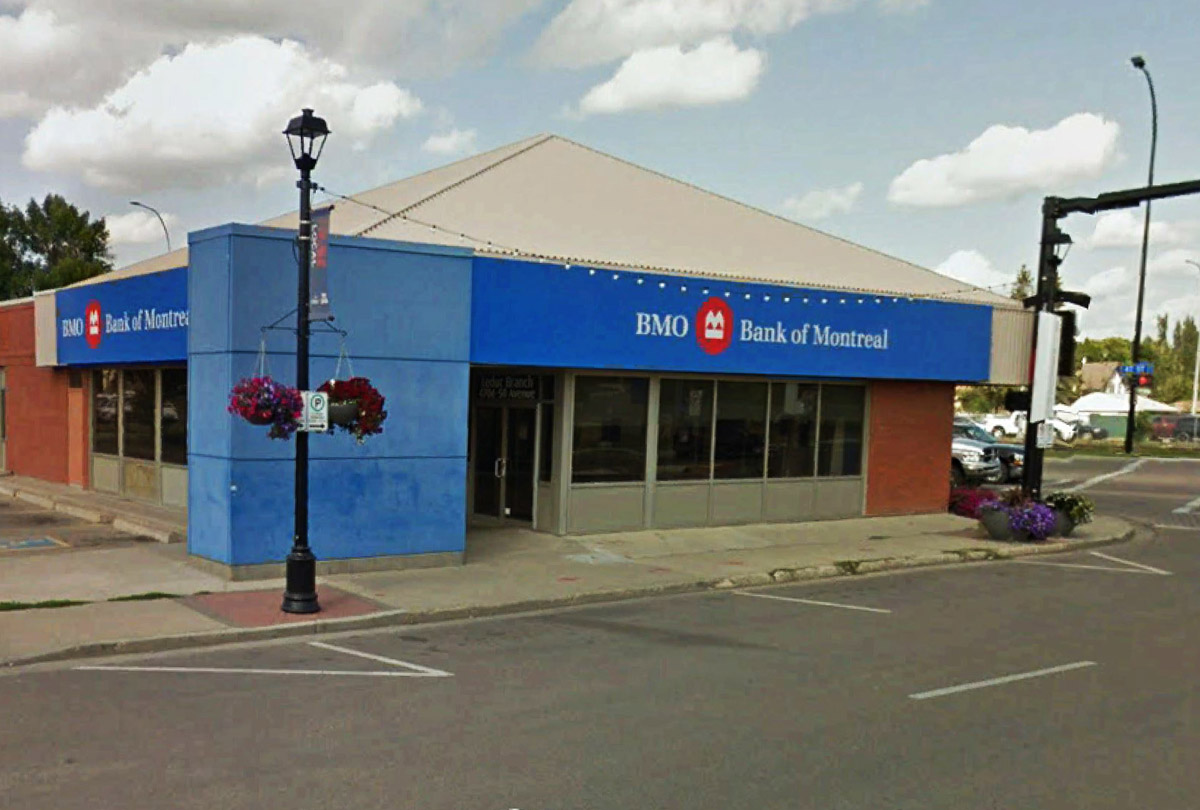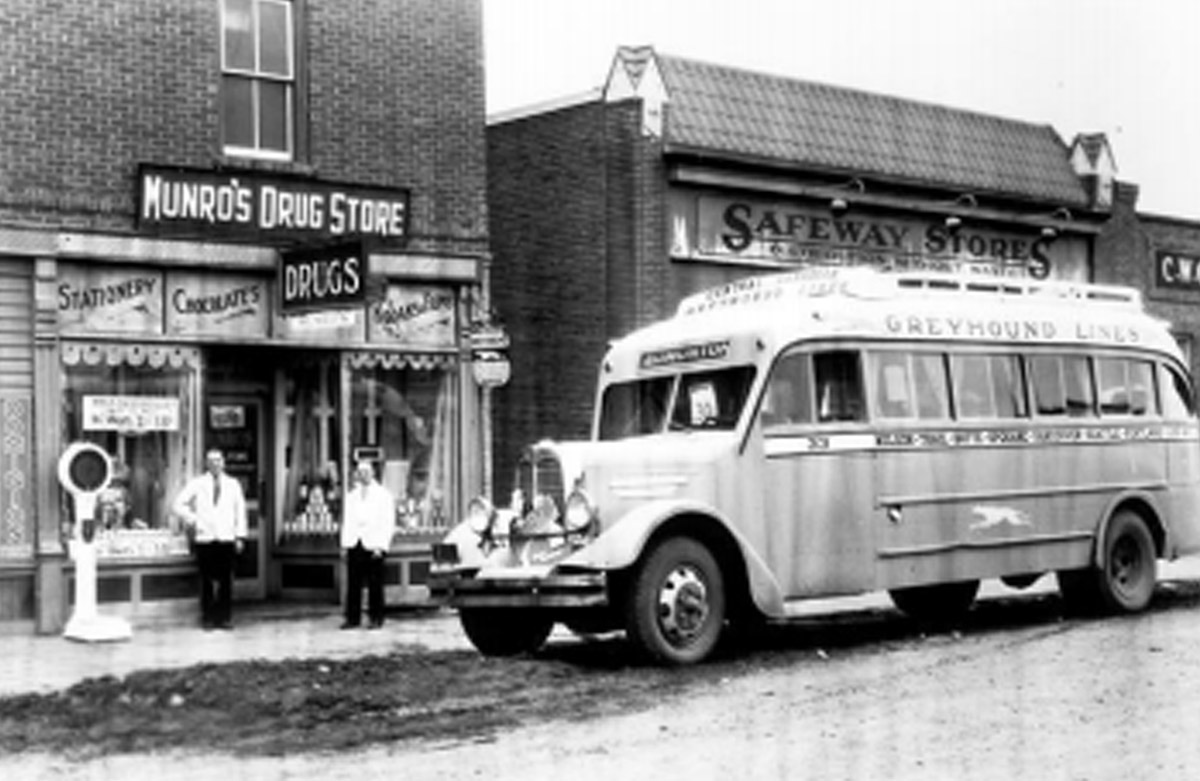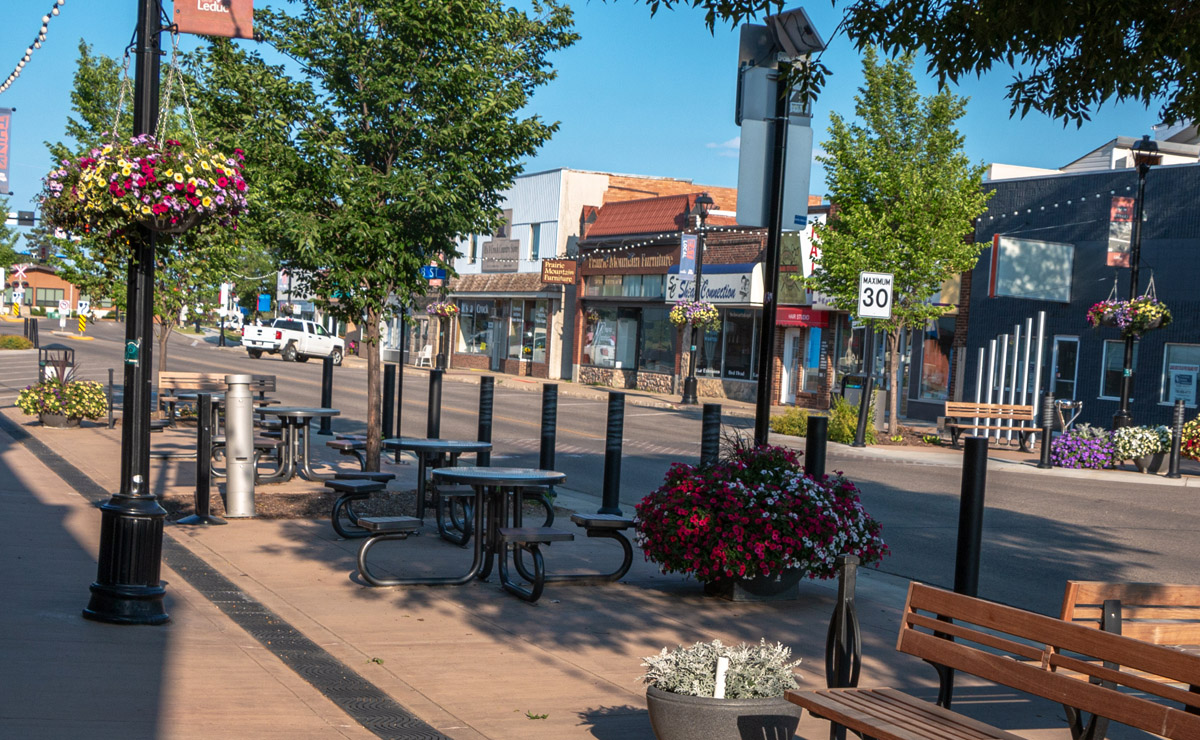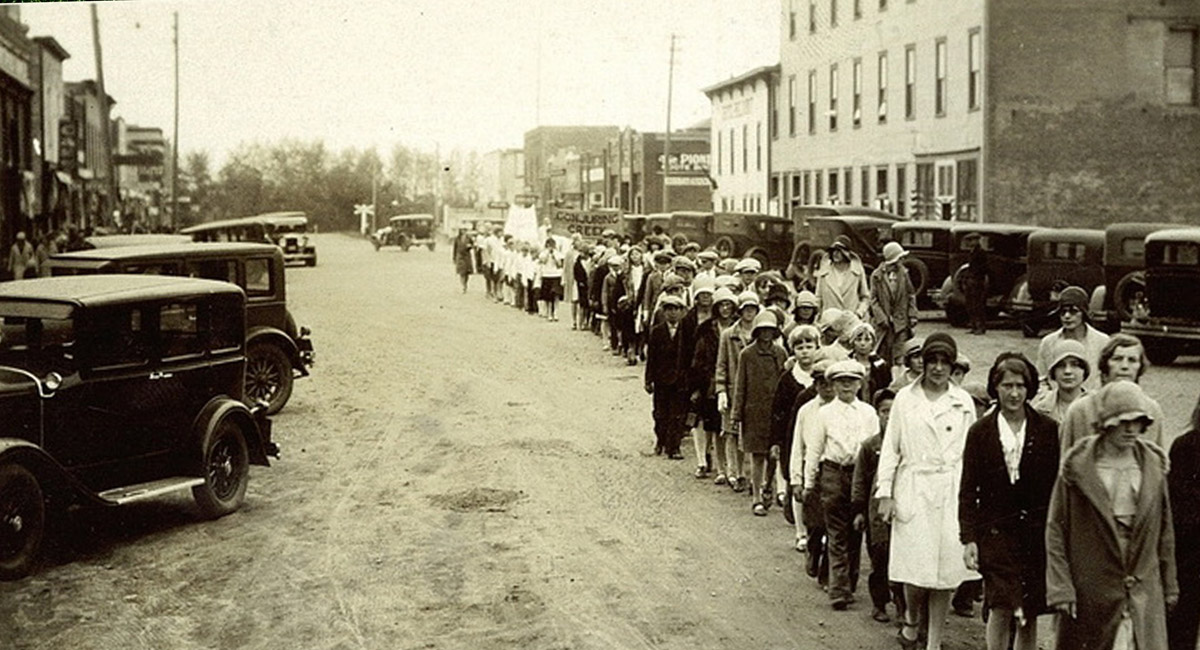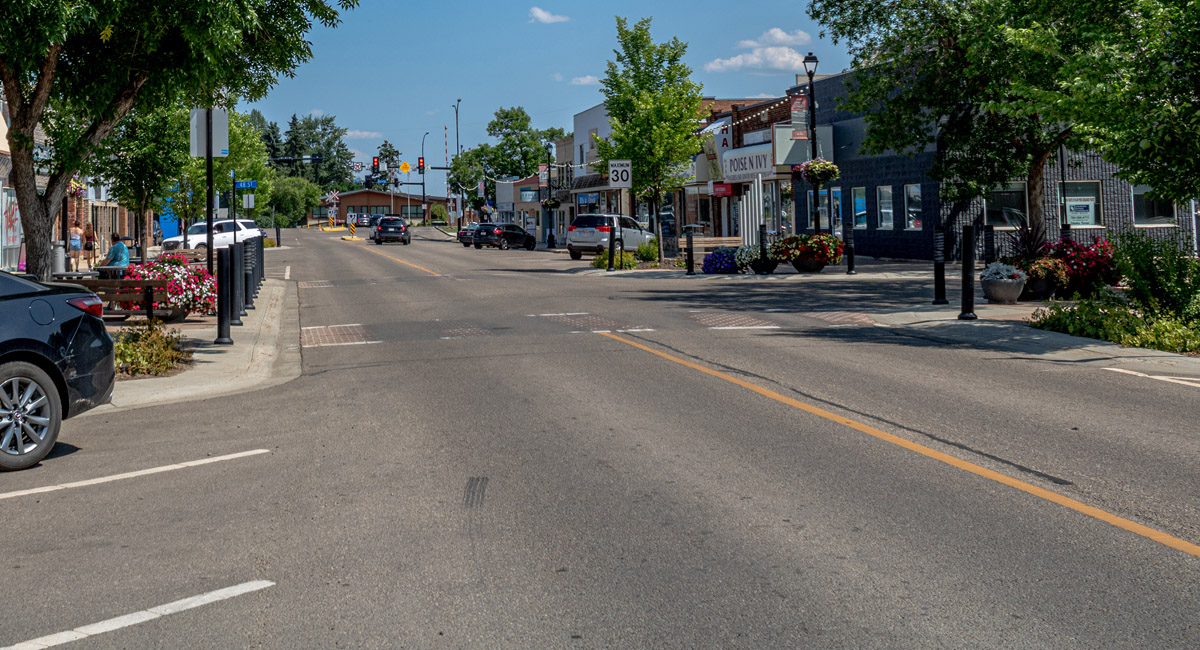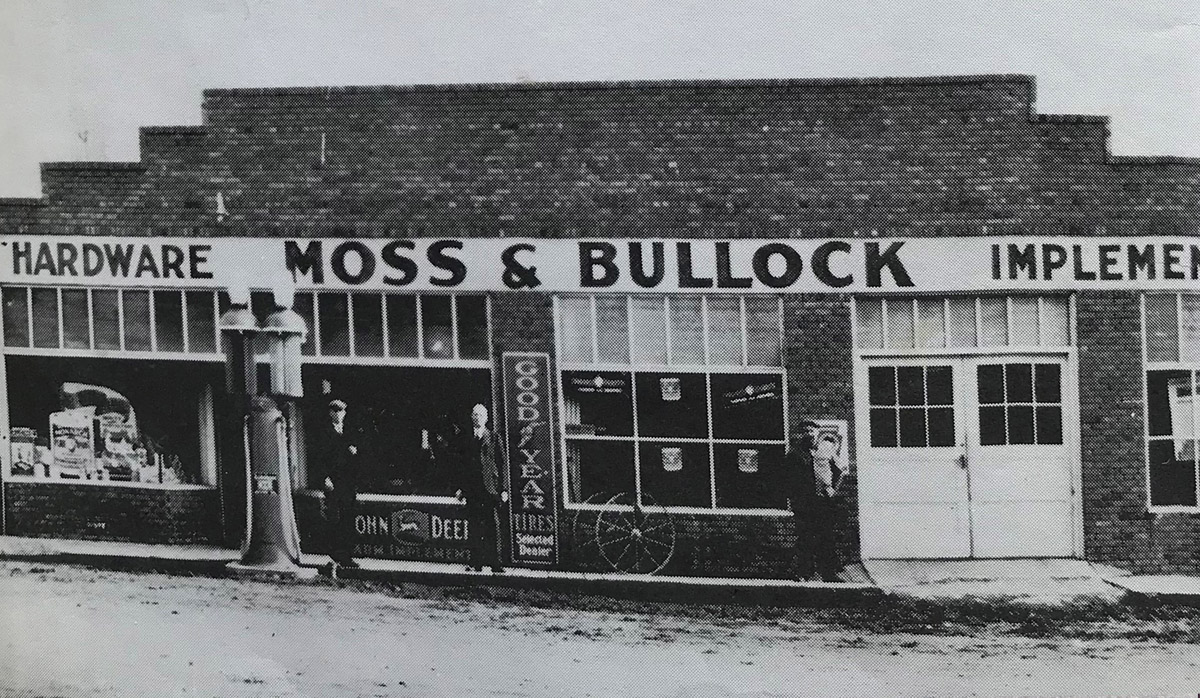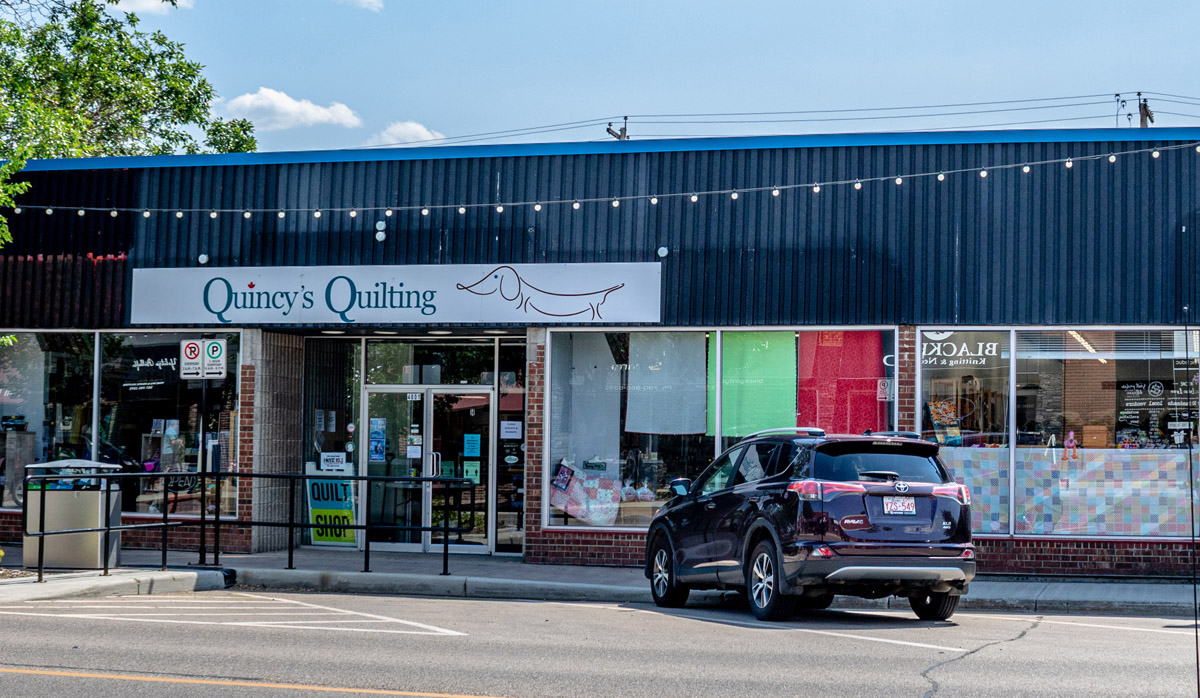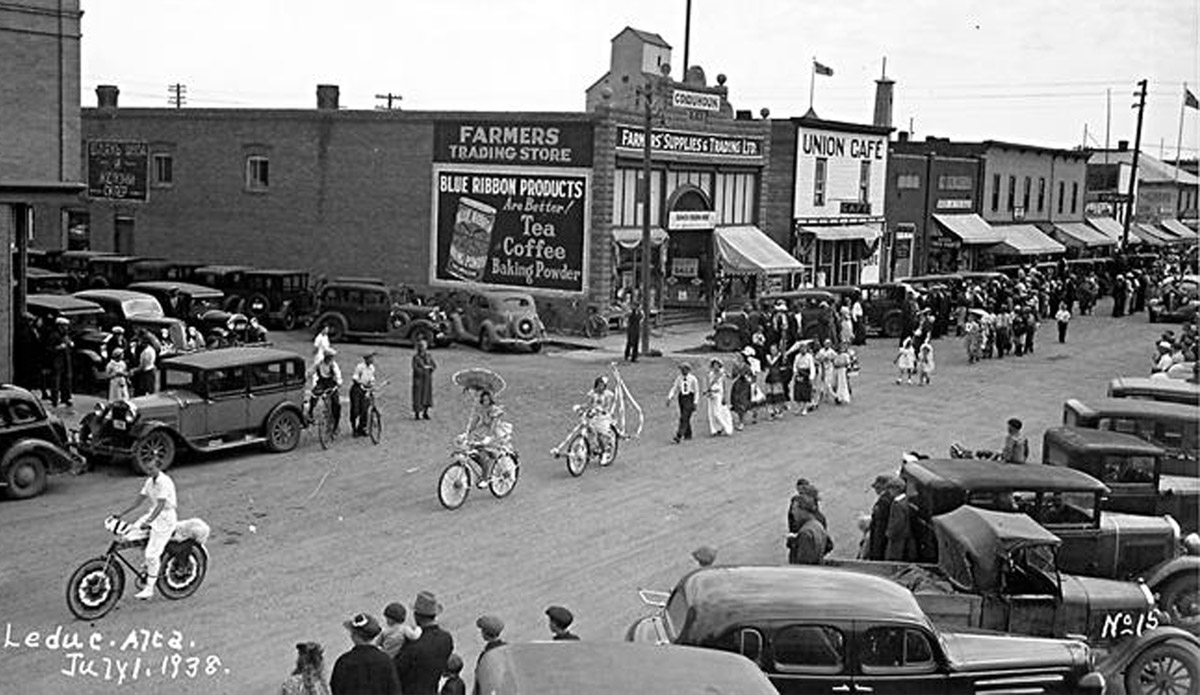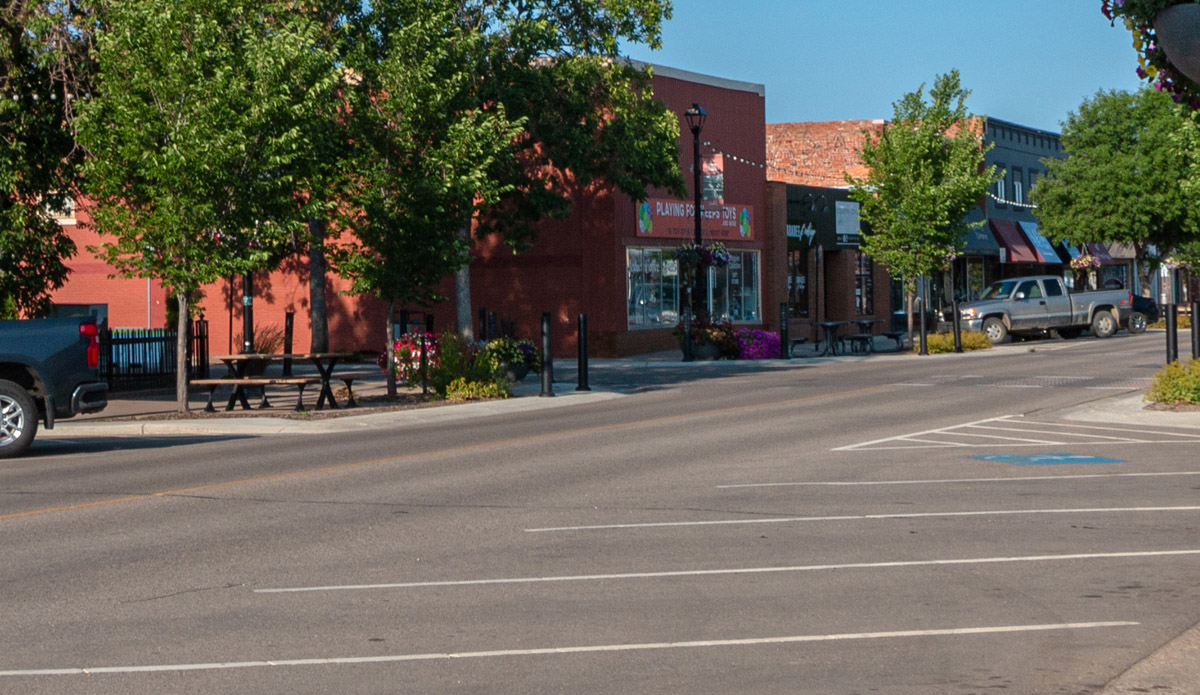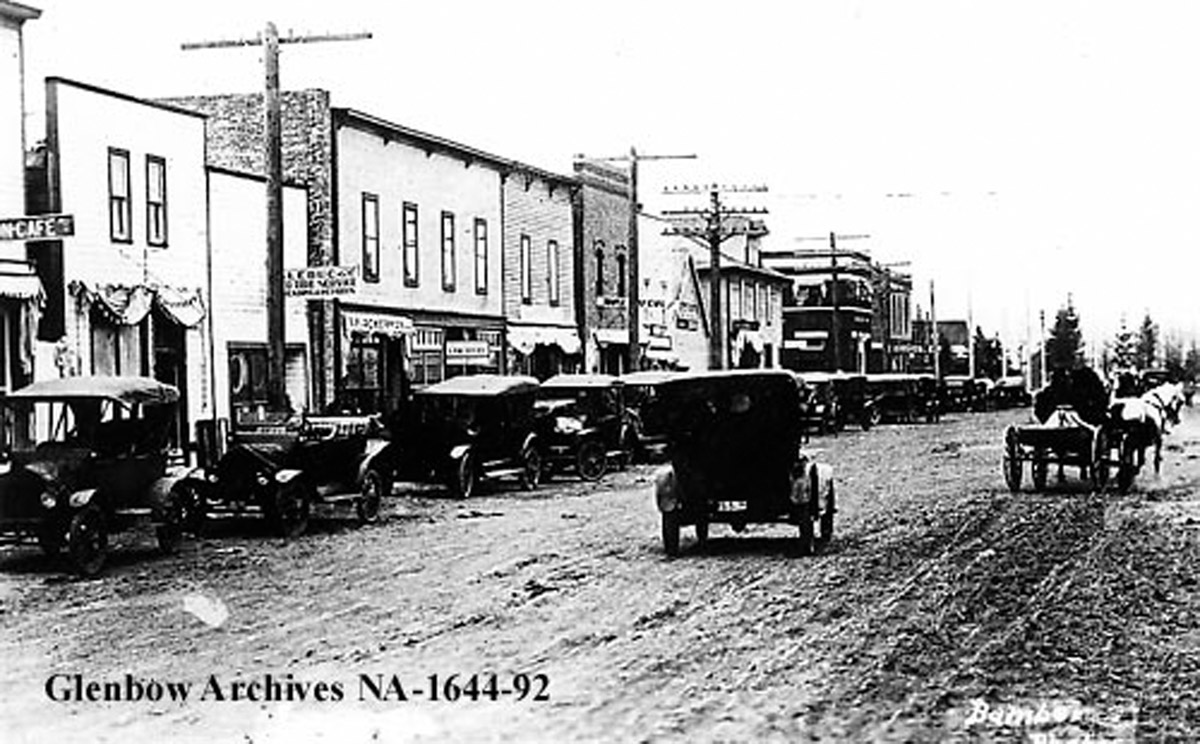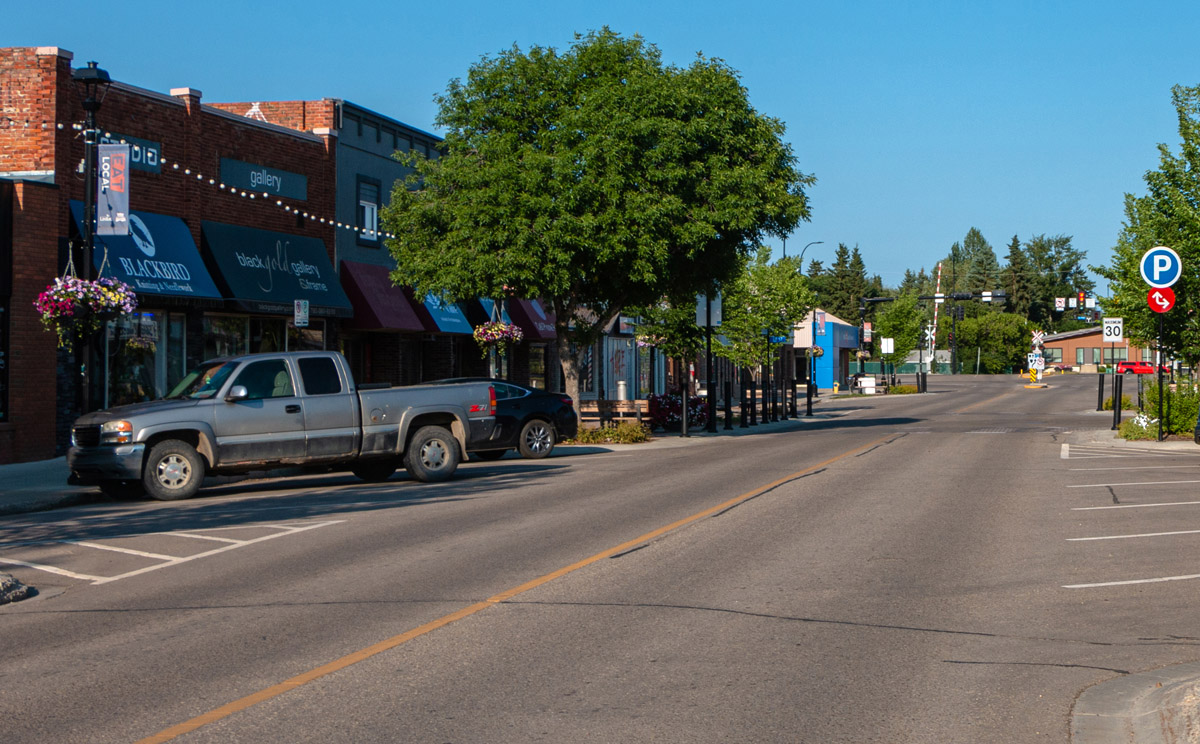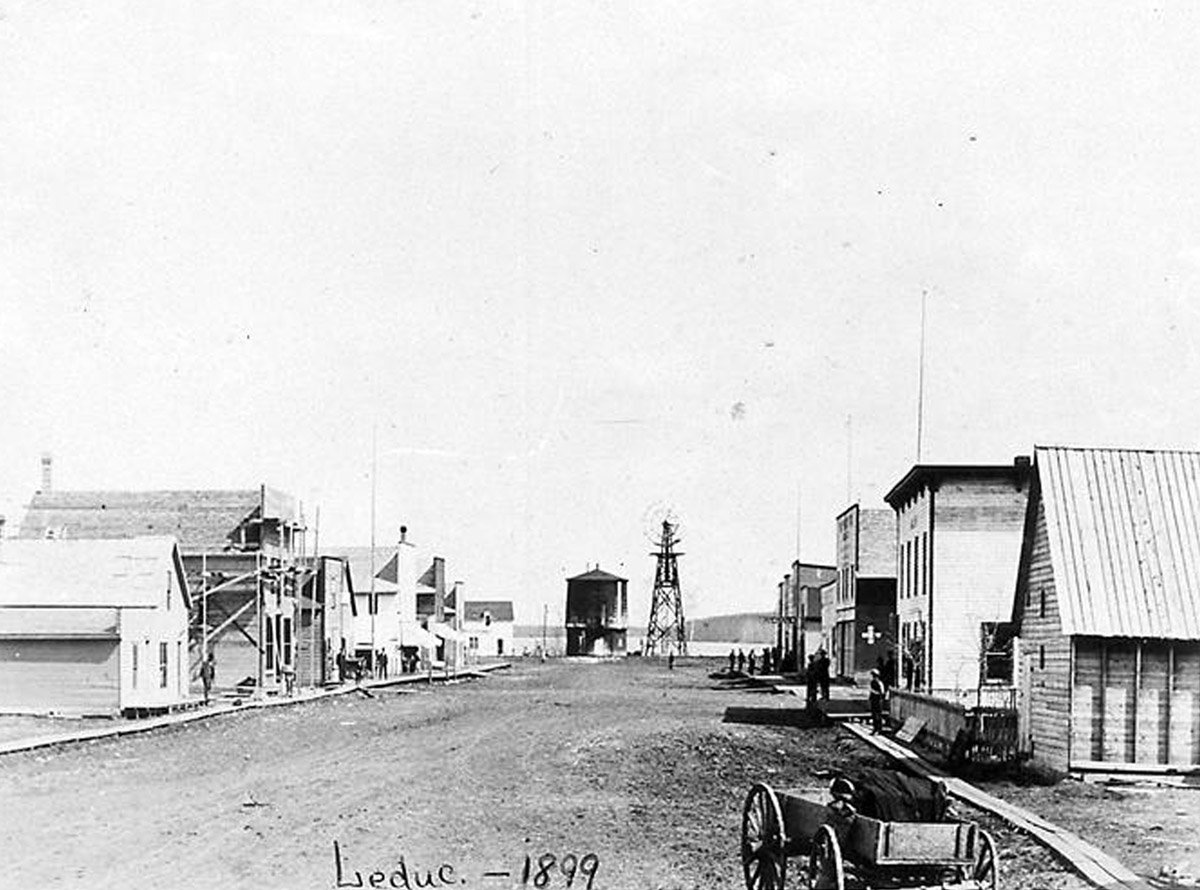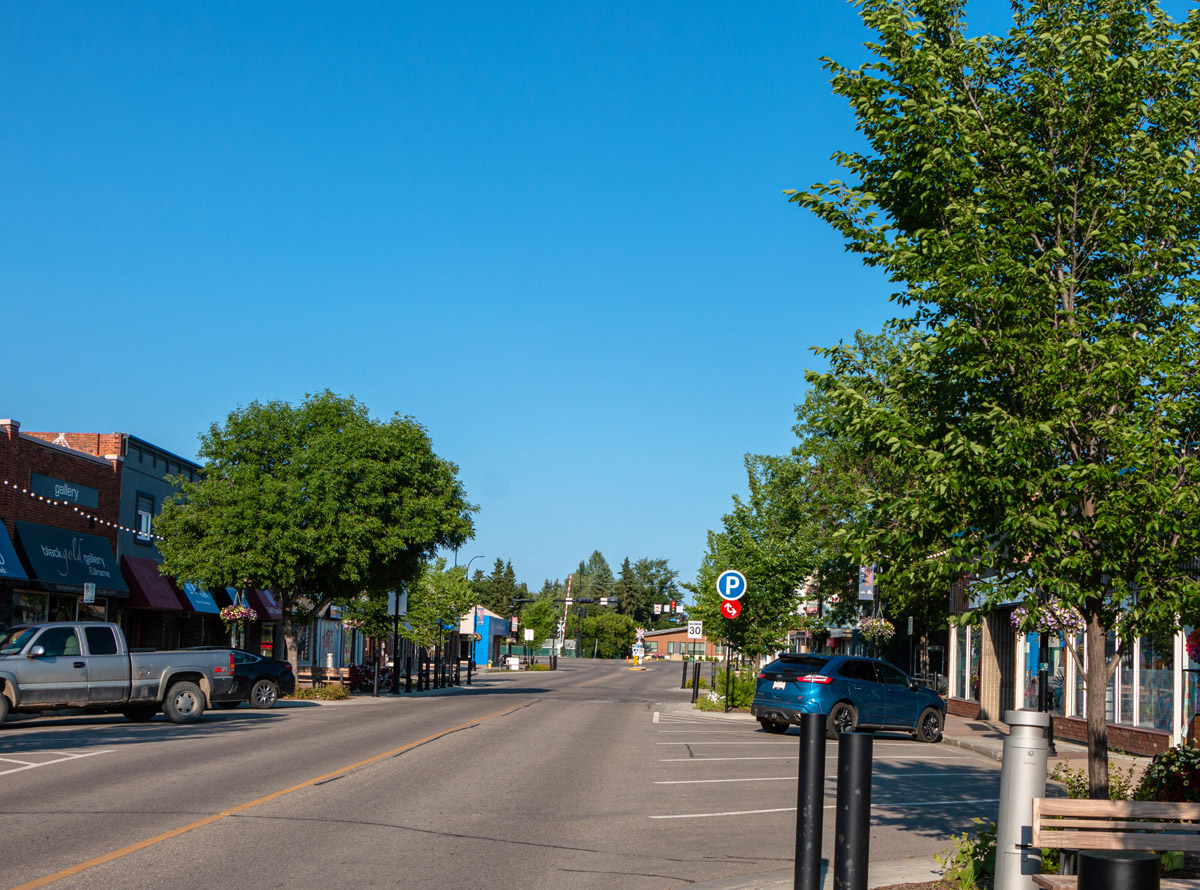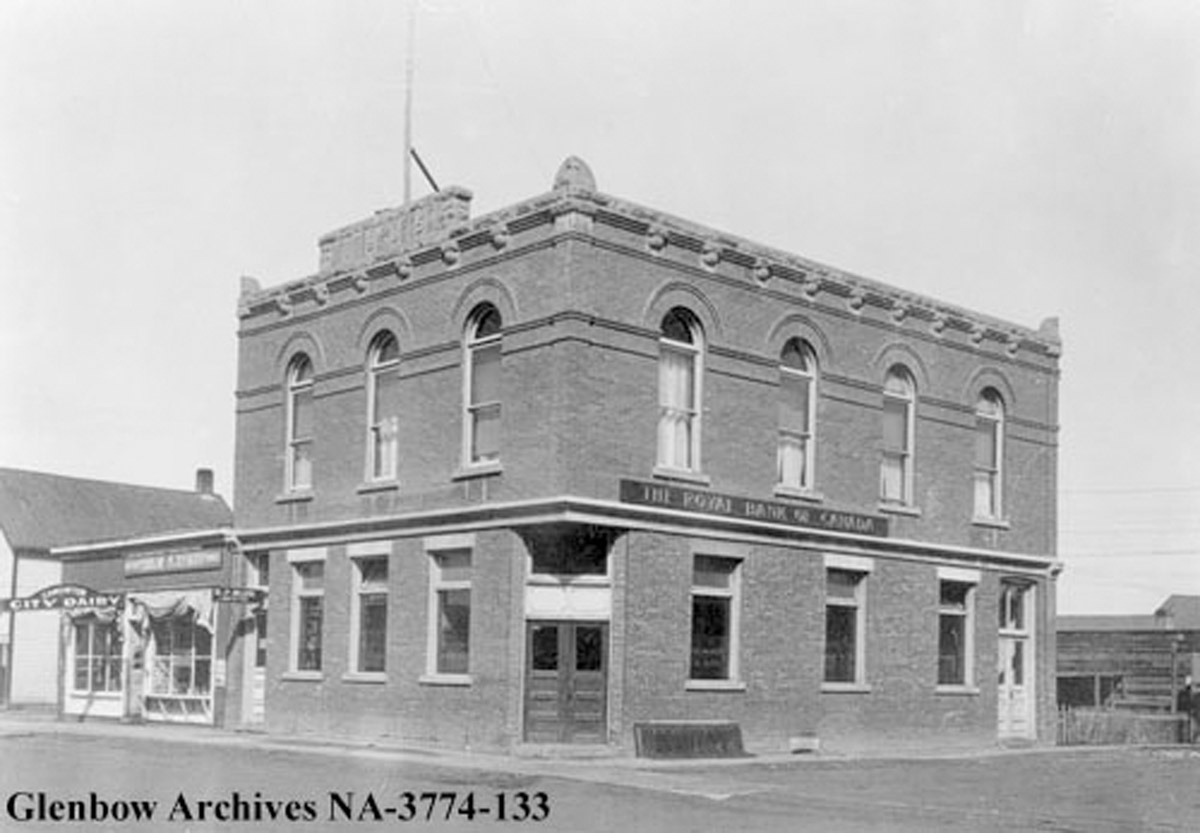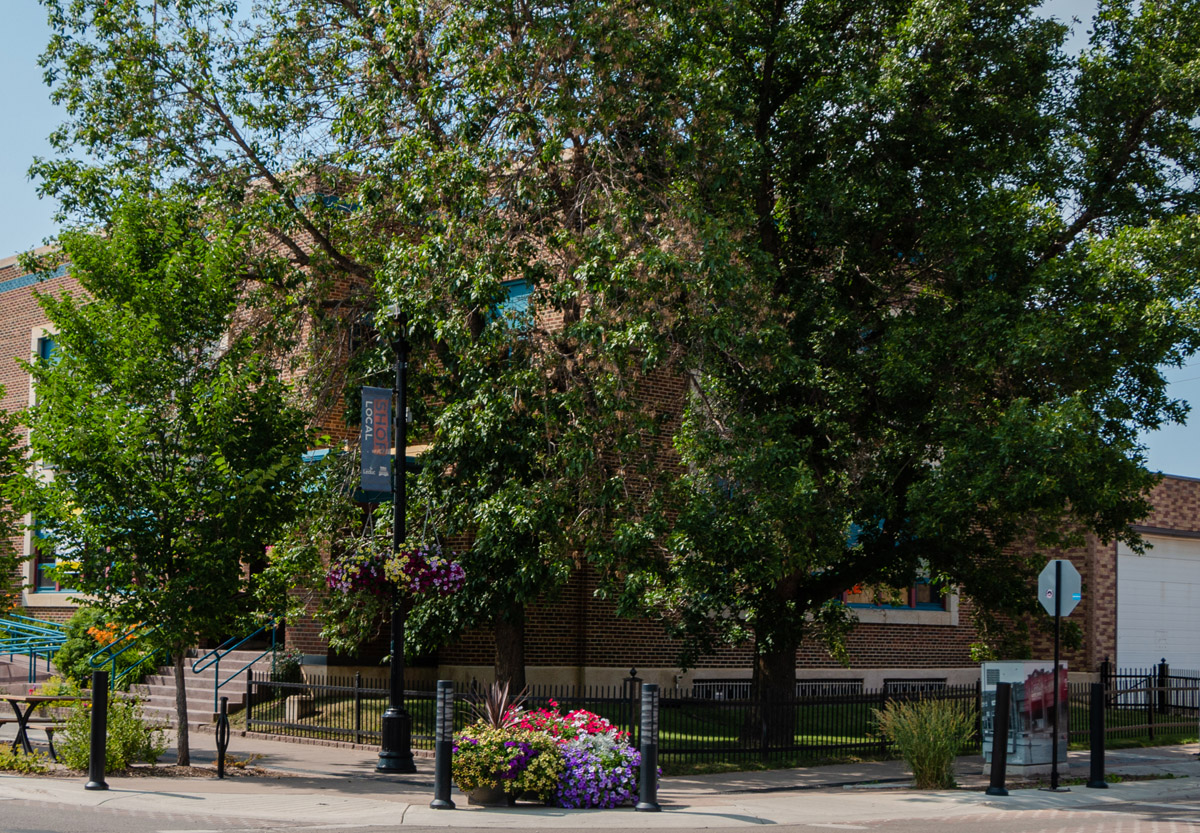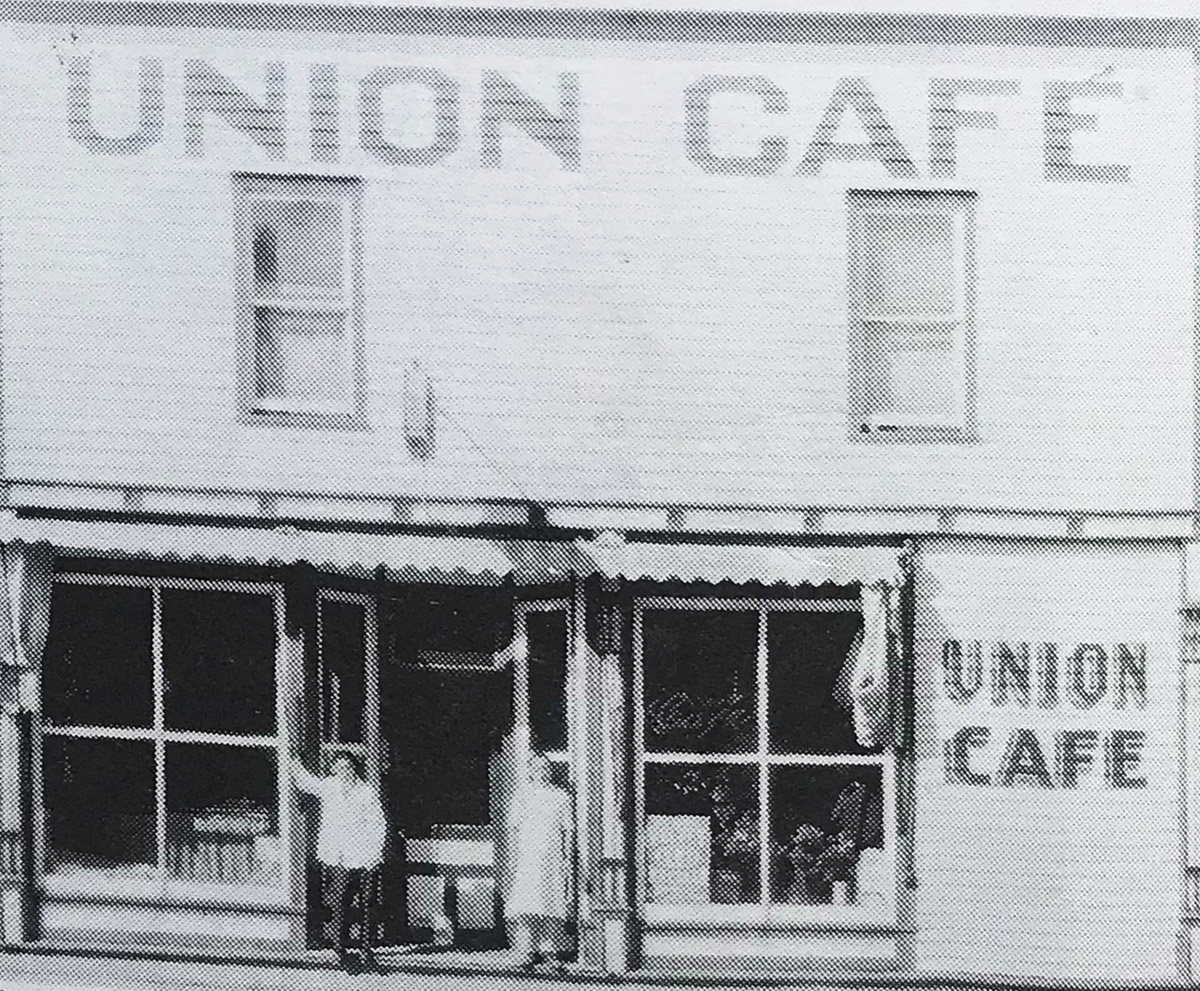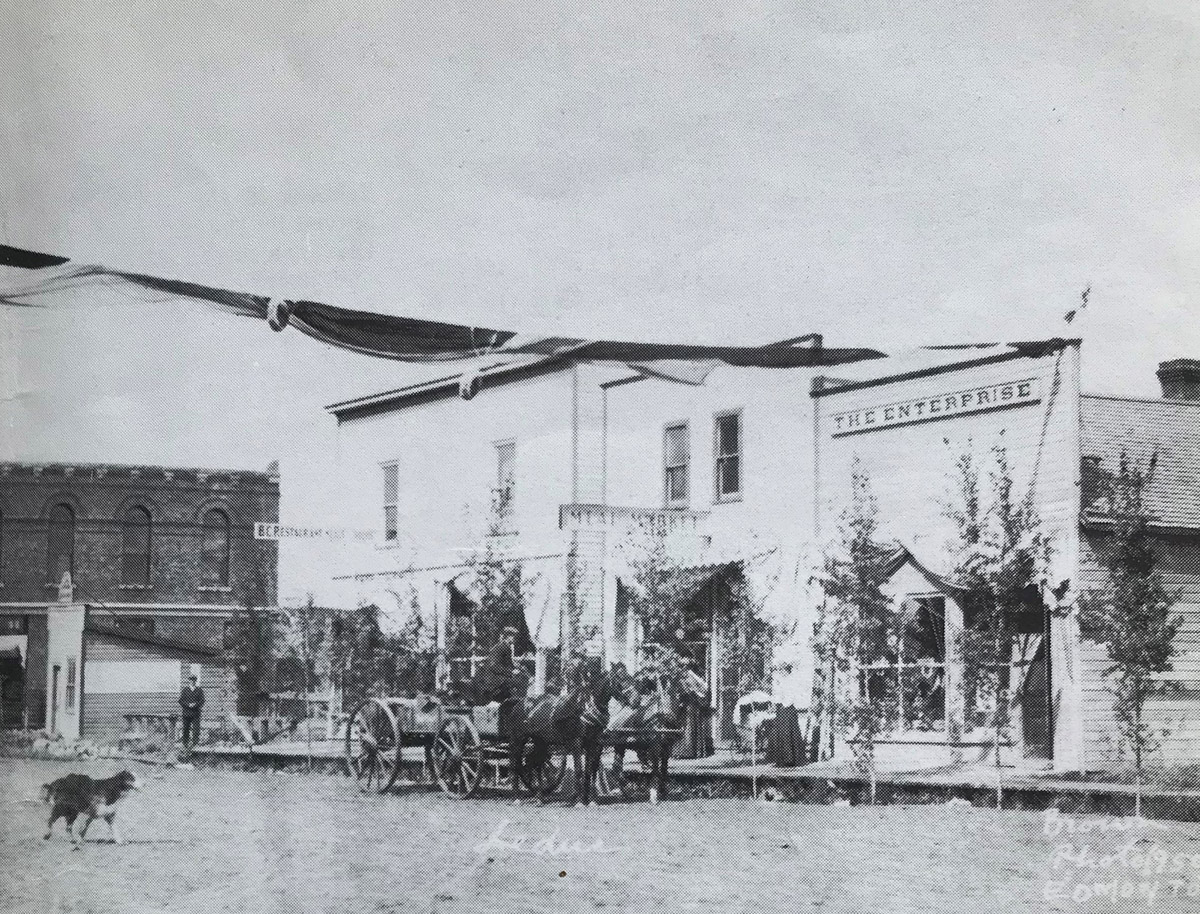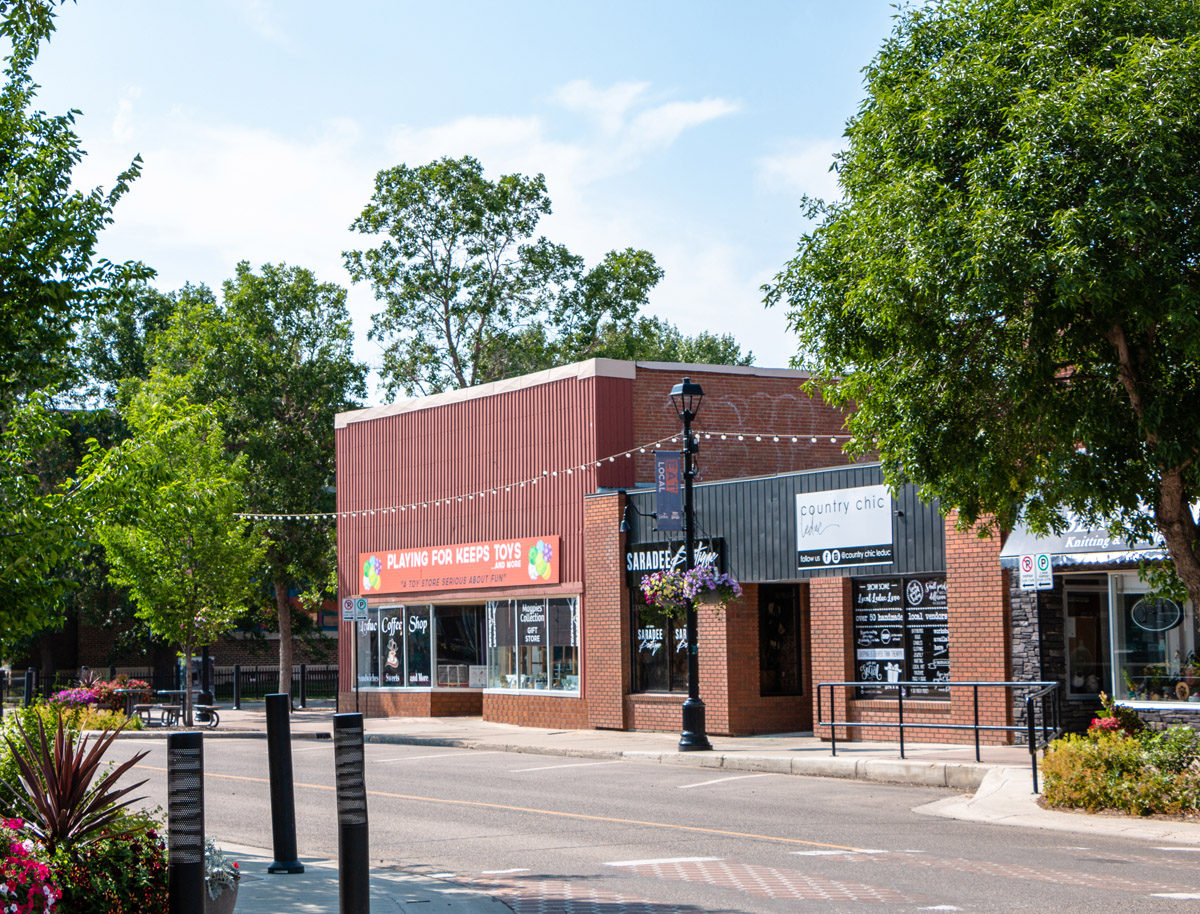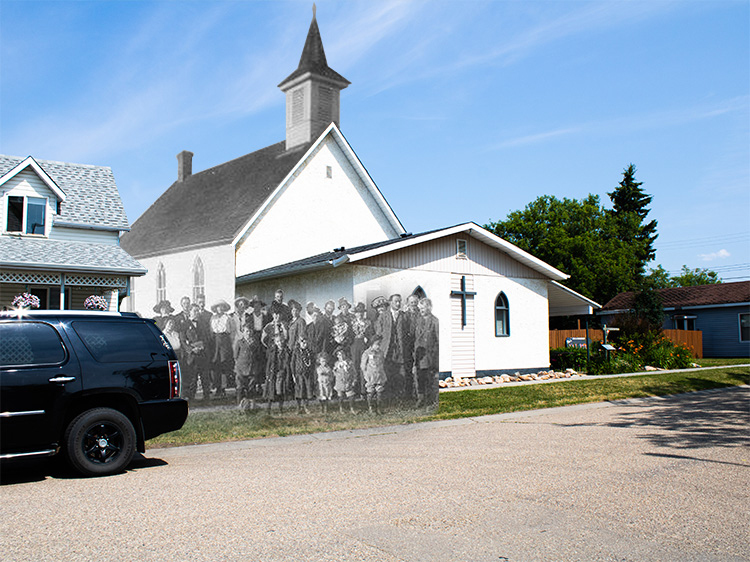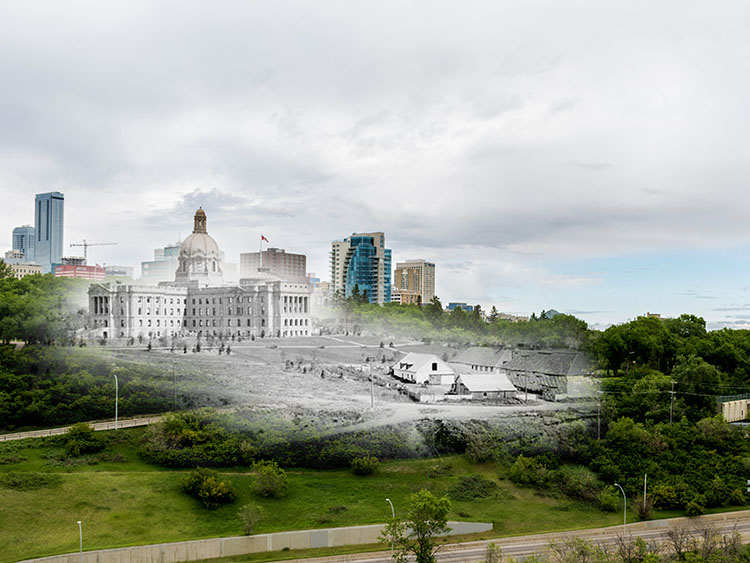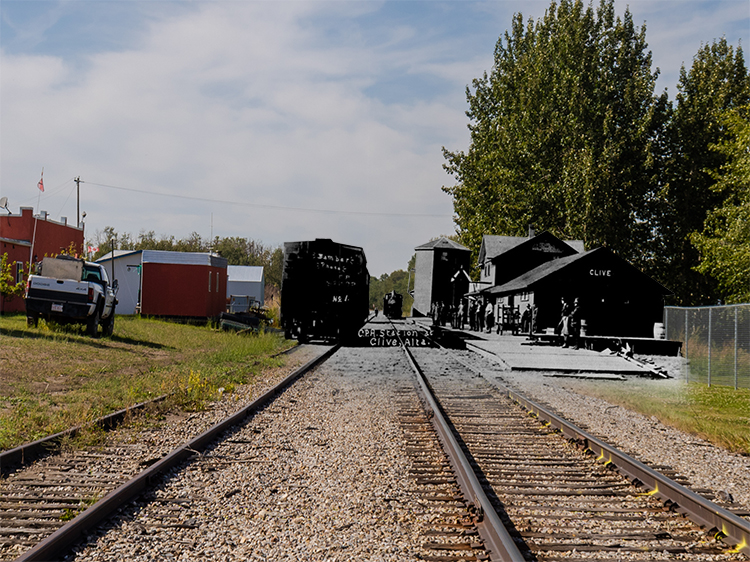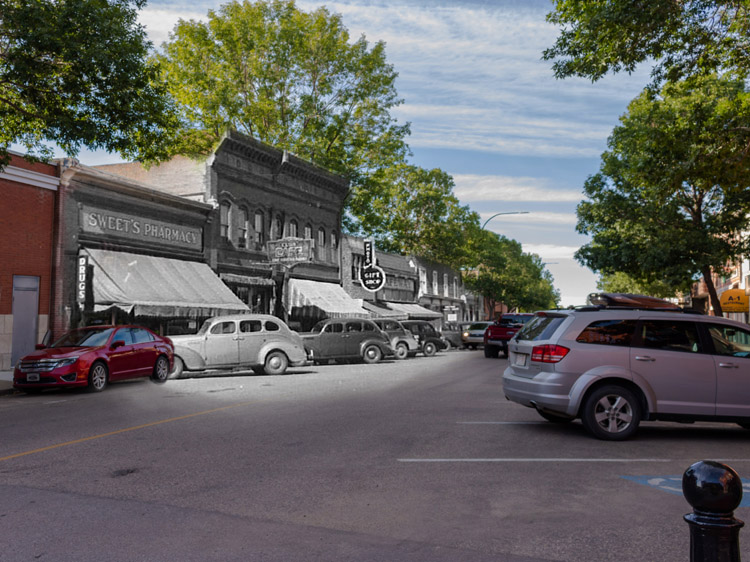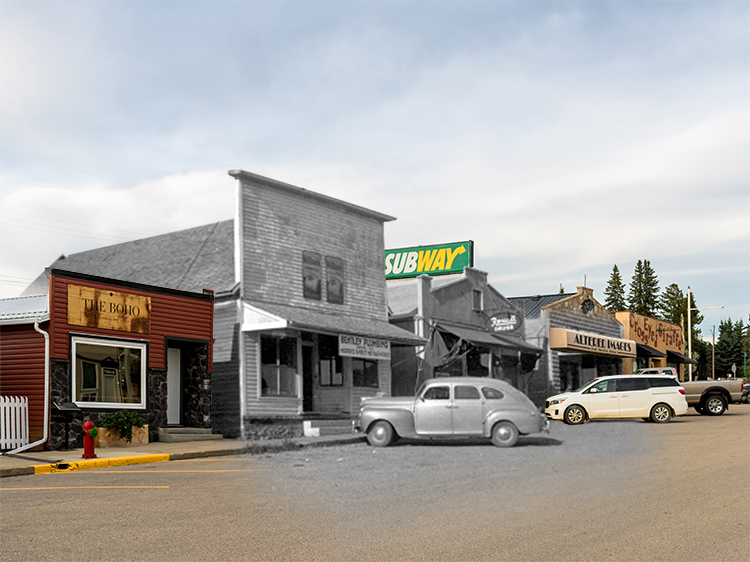Walking Tour
Leduc's Downtown
Growth of a Prairie Town
By Elyse Abma-Bouma

City of Leduc Photo Collection
This tour of Leduc’s downtown will familiarize you with the history of Leduc, telling you the story about how this city went from a telegraph station on the Calgary Edmonton Railway to the thriving community it is today. Through tragedy and celebration, take a journey back in time and see Leduc from its beginnings.
Leduc is located on Treaty 6 territory, home to the Plains, Wood Cree, Nakota, Saulteaux, and Dene nations. Treaty 6 was signed on August 21, 1877 agreeing to peace and mutual respect between settlers and Indigenous peoples. We are all treaty people.
This project was completed in partnership with the City of Leduc.
1. Dr. Woods House Museum
City of Leduc Photo Collection
ca. 1940s
A small crowd of men and women gather at the unveiling of a plaque at 49th ave and 48th street to mark the original location of the Merchant Bank of Canada. It's also the site of the Dr. Woods House Museum, which is located just to the left out of shot.
We begin our tour at the home of one of Leduc's first doctors, Dr. Robert Wood. Dr. Wood built this home in 1927 where he resided with his wife Olive and their family until his death in 1936. After his death, Mrs. Woods sold the house. It changed hands four times before it was obtained by the city of Leduc and became the museum you see in front of you today.1
During his time as the town's doctor Dr. Woods saw Leduc go from a quaint little hamlet to an established town with the traits of modern life we take for granted, like sidewalks and a sewage system. However, Robert Woods did not originally come to Leduc to be a doctor, he came to homestead.
* * *
Dr. Woods began his journey from Kansas to begin the tough life of a homesteader in the great open prairie. After paying his ten dollar legal fee he was given his 160 acres of unworked land in 1902. After three years, Dr. Woods had enough of the sweat and toil and decided to begin practicing medicine again. With some assistance from others in the community, he convinced the residents in Leduc and the surrounding area to contribute $2.00 per year for him to tend to the people of Leduc County.
The life of a prairie doctor required extensive travel (sometimes for days at a time), improvisation, being 'on call' at all times, and responsibility for the health of the entire area. Dr. Woods' house was built as both a home and a treatment center so that patients could come to him for the care that they needed.
2. The Telfords
ca. 1940s
Looking down what was once called Telford Street, we can get a glimpse of Leduc as it once was. The bending gravel road with small trees lining the street and more permanent homes being built to expand Leduc. But how did Leduc come to be? Why this spot? Who lived here?
* * *
Though today Leduc is known for its oil boom or the International airport, it began as a telegraph station on the Calgary-Edmonton Railway line in 1891. Thus begins the story of Leduc as a nexus for the surrounding communities bringing in cream, crude oil, and wheat from around the countryside and shipping out butter, refined oil, and flour in return.1
In its early days, Leduc wasn’t known as Leduc (its telegraph station was named after Father Leduc, which is how it eventually got its name) - but Telford’s Place, after Robert Telford. Robert Telford came to the area in 1889 after leaving Quebec for the United States in search of land to begin a homestead. At this time, the sentiments of British colonialism ran deep in Canada's west and Telford felt drawn north to join the efforts of the North West Mounted Police quell the Metis resistance, and claim land for European settlers deemed worthy of the Canada that the British Empire desired to craft.2
So, Leduc grew from a telegraph station to Telford's stopping house, and then included a handful of homesteads, farms, a harness shop, and a lumber mill. As time passed and families grew, schools were built, and churches became centers of cultural activity and places to gather. Clubs and sports teams were born that further fostered a sense of community and belonging. Soon, Leduc would be abuzz with restaurants, businesses, hotels, homes, and recreation spaces. It soon became the thriving city that it is today.3
3. Priaire Main Streets
City of Leduc Photo Collection
ca. 1920s - 1940s
Here we can see a busy day on Main Street in the wintertime. The street is filled with parked cars, along with a single horse-drawn sleigh navigating the snowy streets.
Prairie Main Streets are something of a marvel for small communities in Canada's west. The ability of a single thoroughfare to bring together and foster community has a beautiful simplicity about it.
* * *
Though Main Street may have started as a functional collection of necessary businesses, by the 1920s town residents desired more from their beloved centres. Recreation and amusement opportunities were sought out by upcoming generations who prioritized sports and entertainment venues such as curling rinks, skating ponds, and theatres.1
"By the end of World War I, it was generally accepted throughout the prairies that recreation drew business to towns. This made it important for a town to offer 'amusement and education' to farm people and to welcome them as friends since on was 'apt to do business with those you know and like.'" 2Even today, Main Street remains important as the keeper of heritage and reminders of a bygone era. Here you are standing on the 'main drag' and seeing just how things have changed and progressed throughout the history of Leduc.
4. Evolution of a Prairie Building
City of Leduc Photo Collection
ca. 1921 - 1926
The C.W. Carroll land office was built in 1921 in a style that represents typical prairie architecture of the time. Built on the site where a meat market once stood, the land office replaced a wooden structure with this smaller brick building you see today. The building remained a land office providing Leduc with all of its insurance, land valuation, and auctioneering needs until 1924 when C.W. Gaetz bought the business and it became Gaetz Agencies.
* * *
In the case of the building in front of you there are only a few alterations from the original. For example, the entrance has been moved to the west side of the building; the transom windows (the windows above the door) replaced; and the facade angled away from the main street. There are a few other cosmetic alterations to the exterior that together make the building appear much different from the original.
This building also only had a crawl space until it was later expanded to create a basement for more storage.1
Another factor to determine significance is who owned, patronized, or worked at these locations. C.W. Carroll and C.W. Gaetz are both major figures in Leduc's historical narrative.
Charles William Carroll left Iowa for Leduc in the early 1900s and everyone knew him as the 'land man.' Carroll was known to all in Leduc for his auctioneering skills, and as a land valuator and insurance broker.2
Clarence Wilberforce Gaetz came up to Leduc from Red Deer where his father, Reverend Gaetz, had a homestead. In 1906 Clarence "Clare" Gaetz became the first mayor of Leduc. He began to work on improvements in the town with a small budget. One of his accomplishments was beginning sidewalk construction in the town.3
Today the building still stands, housing yet another business and continuing to serve the community of Leduc.
5. November 11, 1950
City of Leduc Photo Collection
1950
The Leduc Hotel was built in 1902 and was originally called the Sutherland Block. On November 11th, 1950, the town was attending a Remembrance Day service when suddenly there were two explosions in the natural gas line, levelling the hotel, resulting in the death of ten people.
* * *
"The fire-blackened ruins of the pioneer Leduc hotel -- death trap of 10 persons in an explosion which destroyed the building Saturday -- symbolize the blackest day in the history of the oil-boom town of 2,000 population. It might have been a red-letter day in the town's history had it not been for the explosion -- the worst hotel disaster in Alberta's history. Leduc 21 miles south of Edmonton was to have been serviced with natural gas Saturday.The two-storey brick and frame hotel was ripped asunder by a blast heard 17 miles away shortly before noon Saturday, just as Leduc residents returned from Remembrance Day ceremonies. The hotel beverage room was to have opened in five minutes, and within 15 minutes it would have been filled. Had the explosion occurred then, residents fear the death toll might have been closer to 100." 2The initial blast knocked everyone in the surrounding area off of their feet. Some employees were pinned by furniture and such, the initial explosion was heard by all of Leduc and the surrounding area. It was the second explosion that started a fire:
"As I rushed to the building all I could hear were screams, screams, screams. I helped one man out. He had a broken arm and was in terrible pain. There was one girl we could not help. I saw a woman on her hands and knees trying to crawl out. She too was screaming. But we couldn't help her. She was too far inside the wreckage and before we could get to her she disappeared." 3Amongst the dead was Edith Miller, a waitress; Orysia Megley, daughter of the owner; Steven Fenniak and Emil Abal who were beverage men at the hotel; Drillers Allan Powell and Art Manneville; Elmer Baird, Bill Brohman, and Fred Kincaid. Nadia Megley, oldest daughter of owner John Megley, was hospitalized by the blast but fortunately survived.
6. Drug Stores and Supplies
City of Leduc Photo Collection
ca. 1930s
Munro's Drug Store was built in 1892 by Charles Sheppard. This building in front of you originally housed one of Leduc's first drug stores as well as hardware stores. After a few short years, Sheppard sold the drug and hardware store to C.W. Gaetz, a prominent citizen and the first mayor of Leduc, who ran the business for many years. 1
* * *
Though Main Street may have started as a functional collection of necessary businesses, by the 1920s town residents desired more from their beloved centres. Recreation and amusement opportunities were sought out by upcoming generations who prioritized sports and entertainment venues such as curling rinks, skating ponds, and theatres.1
"By the end of World War I, it was generally accepted throughout the prairies that recreation drew business to towns. This made it important for a town to offer 'amusement and education' to farm people and to welcome them as friends since on was 'apt to do business with those you know and like.'" 2Even today, Main Street remains important as the keeper of heritage and reminders of a bygone era. Here you are standing on the 'main drag' and seeing just how things have changed and progressed throughout the history of Leduc.
7. Change and Preservation
City of Leduc Photo Collection
1909
Looking down Main Street in this photo from 1909 we can see a classic prairie town scene: dusty dirt road, horse and wagons, and people meandering the sidewalks. Power lines newly installed on the street bring electricity to homes and businesses in Leduc. Wooden shops line the street filled with produce, dry goods, and fresh meat for sale.
Take a moment to notice the shape of the street's shops in 1909. Notice the sidewalk and the line of boxy shops standing side by side? With that in your mind's eye, notice the current shops and street, see any similarities?
* * *
"Heritage conservation encompasses the identification, protection and promotion of things that are important in our culture and history. The term heritage covers a wide range of tangible things: it can be an object in our built environment, such as a railway station, a bridge or a neighbourhood." 1Heritage preservation can also show what a community values. The choice of buildings and determination of why they are important are defining features of communities such as Leduc. Leduc has fourteen buildings on its heritage register and most of the buildings are from the earlier 1900s and on this street or one nearby.2
The street looks much different than it did in 1909, but it is still recognizable over 100 years later. Its boxy fronted buildings still stand a line and are full of a variety of shops and businesses that serve the community. The efforts of the city to preserve its history are very visible, you just need to know where to look.
8. Children and School
City of Leduc Photo Collection
1930
In 1892, Leduc had a single school; in this photo from the 1920s, you see almost the entire student body. By 1965, Leduc had several schools to accommodate the growing population.
* * *
As the town grew, so did the need for schools, and other cities took note of Leduc's growth. The Edmonton Bulletin reported in early 1911:
"Leduc was incorporated as a town in 1906 and in September 1909 had a population of 500. It has been growing steadily and now has possibly a population of 600. The total assessment for 1910 was $346, 105.00 inside the town limits and a total of $422, 281.00 in the Leduc School District which includes a larger area that the incorporated town." 2Being a student on the Canadian prairies meant many different things depending on who you were and what you looked like. While white children may have gone to the two storey schoolhouse in Leduc, Indigenous children were subjected to abuse, neglect, and all other kinds of harm. Just south of Leduc in the area called Maskwacis (then named Hobbema by settlers) stood one of Canada's largest residential schools, Ermineskin Indian Residential School.3
The school in Ermineskin was started by the Catholic Church in 1916 and did not close its doors until 1973. Flora Northwest was one student who was taken from her grandfather and was forced into the school. Flora remembered being beaten and verbally abused in the harsh environment of the school:
"At the school, her long black hair was cut off and she was forced to speak English, even though she didn't know the language. She said she was laughed at, ridiculed for who she was. She was strapped for speaking Cree and witnessed much worse abuse, she said." 4Schools in Canada have looked different for children depending on how they looked. For some, like Flora, school was traumatizing as she, and others like her, were removed from their homes to attend school. For others, school is something they look back on fondly.
9. Construction and Business
City of Leduc Photo Collection
ca. 1920s
Three men stand atop a frame of what would become the Moss Hardware store in early Leduc. Adding on to a thriving Main Street, the hardware store supplied Leduc with lumber, nuts, and bolts, and eventually gasoline.
* * *
Early settlers and homesteaders' construction methods were based on what was readily available and quick to build. Borrowing from the Metis tradition, log homes began to pop up all over the prairies. The logs that homesteaders were able to find were not always the ideal for building shelters, but they would use what was available and make do.
"Palliser had noted in 1858, much of this timber was too poor to export, but it 'would serve the purpose of the settler and suffice to construct houses and furnish him with fuel.'" 1As time progressed, saw mills came to Alberta and created a supply of machined lumber that was more suitable for building. However, the mills could not keep up with demand and supply was frequently lacking.2
Moss Hardware was not only built of milled lumber, but likely went on to sell it as well, a true mark of construction progress in Leduc.
10. Celebrations and Community
City of Leduc Photo Collection
1938
A Canada Day parade in 1938 celebrates seventy one years of Confederation. Leduc's annual parade fills Main Street with decorated cars, floats, and bicycles in celebration of another year of independence and freedom. Along the street, we can see the Union Cafe, Farmer's Supplies & Trading Store, and the Maple Leaf Cafe. Celebrations were a community affair with contributions from many different cultural groups, both old-timers and newcomers.
* * *
Most of Leduc’s early settlers were of British descent, with many being born in eastern Canada or immigrating directly from Britain. However, Leduc also had a good deal of German settlers; in 1893, 175 people Germans settled in Leduc and by 1896, that number was up to 650. Like many groups, German settlers formed their own community; they formed organizations and clubs and made newspapers. However, this did not mean they were separate from the rest of Leduc - the German community had many prominent residents, including C.W. Gaetz and politician M. E. von Amerongen.1
As campaigns continued by the Canadian government continued to fill the west with 'desirable' farmers, more immigrants of European descent began to arrive, including Dutch and Ukrainian immigrants. During the first half of the 1900s there were also a handful of Chinese immigrants who arrived in the Leduc area starting a cafe and contributing to market gardens in that area.
"Early-century immigrants largely were shut out from power, privilege, and wealth in the prairie city. But at the centre of the immigrant's story was a vital community. In a sense it was an ethnic ghetto, a gathering of people, but it was much more...providing the vocabulary, symbols, and understanding by which life made sense and social action was ordered." 2
11. Dirt and Dust
1920
Looking down 1920s Main Street we can see many differences from today. Horses and cars share the dirt road as people wander the boardwalk to peruse their favourite shops and run errands.
Taken in the 1920s, this photo shows vehicles lining the streets of Leduc's main street, but just five years earlier these streets looked much different. The first car came to Leduc in 1915 and was a Hupmobile Six convertible owned by William Taylor. Dr. Woods quickly followed suit, purchasing his own car to make his house calls much easier and quicker.1
* * *
Now close your eyes and imagine:
Imagine the wooden boards creaking beneath your feet, feel the dust hit your skin with the warmth of the sun.
Take a deep breath and imagine the faint smell of manure mixed with gasoline and fresh baking bread from down the block.
Hear the clang and rumble of a slow moving car driving over potholes. People passing on the boardwalk talking about the latest news in the local paper and complaining about the low price for grain and asking about how the harvest is coming along.
Open your eyes. Now that you have stood on this spot, think about how things have changed in the last 100 years, how so many different people have stood on the spot you are in right now.
12. Wood Before Brick
City of Leduc Photo Collection
1899
Main street in 1899 is unrecognizable compared to the modern version of the area. The dusty road, wooden structures, plank sidewalks and wagons all leading to the focal point of a water tower and wind pump is a far cry from the pavement, shops made of brick and steel, and cement sidewalks lined with flower beds headed towards a traffic light. This photograph from Leduc's early days can teach us about a town's beginnings, and how Leduc escaped a possible tragedy with a simple bylaw.
* * *
"The Council Passes a By-Law Prohibiting the Erections of Frame Buildings Within a Certain Area. Coun. Fetherstonhaugh was the only absentee at Monday evening's meeting of Council. The legislation enacted at this session was probably among the most important that will come up this year, viz. The by law for the prevention of fires." 1Fires proved to be one of the most prevalent threats to small prairie towns. When settlers and homesteaders first arrived at townsites they were in a hurry to build structures for dwellings, to house animals, and for storage of goods. Structures were made out of timber and other found materials and were built speedily for immediate use. The quick construction made sense at the time - they needed buildings, after all; however, it posed one huge risk: fire.
Imagine that a couple of settlers arrive in an area and build a few homes. They are spaced out and everything is well, but after a decade has passed there is now a small network of streets and the blacksmith is right next to the general store which is right next to the saddlery, and so on and so forth. If the blacksmith has a spark go astray all three businesses will go up in flames. Early townsites didn’t have fire departments or running water; if there was a fire, the community would have to haul buckets of water from Telford Lake or other sources and by the time the fires were put out, almost all was lost.
Leduc, like many other prairie towns, passed a bylaw to eliminate wooden structures from high risk areas (like main street) to prevent complete destruction by fire. The citizens of Leduc had most likely heard news of other towns that were destroyed by fire, so Leduc began building with brick and stone to create a main street that would stand the test of time and avoid the fate of those other towns.
13. Banking and Loans
1926
Built in 1905, this building was originally meant as a merchant center for Leduc and housed the Martin & Pyrex Hardware Store for a number of years before it became the Union Bank in 1918. Eventually this building became the Royal Bank of Canada which can be seen in this photo.1
* * *
Early on, banks printed their own money - meaning that there were multiple currencies in circular until the Bank of Canada created its own bills, standardizing money across the country. 2
"If a person in this part of the North-West does any work for, or sells any article to the Dominion Government on Mounted Police account, at the lordly will and pleasure, sometimes of the commanding office and sometimes of no one knows who, a month or two after presenting his account he receives from Battleford a cheque on the Merchants Bank, payable at Winnipeg, a matter of 1,000 miles off. In order to get the money he must mail the cheque to Winnipeg and have the cash mailed back, all at his own risk and at a loss of from sixty to ninety or one hundred and twenty days as the case may be…[if] the mail is not delayed by snow storms or running ice, or lost horses or anything else, there is a possibility of receiving a cheque...in from six to nine weeks from the time the voucher leaves here. The cheque has then to be mailed back, the whole process taking from about one hundred days up to an indefinite period-- with the very likely chance of payment never being made." 3Needless to say, payment by cheque or voucher was not preferable and residents of Leduc and the surrounding area tended to pay with services to keep things local.
14. Union Cafe
City of Leduc Photo Collection
ca. 1910s
The Union Cafe can be seen here on Main Street, its facade towering above the display windows which would regularly have been filled with fresh bread and pastries waiting for the people of Leduc to come in for their coffee and lunch. Union Cafe, which employed locals, most likely started during the 1920s and expanded during the oil boom in the 1940s, which brought newcomers to Leduc.1
* * *
Sew Wong arrived in Leduc in the late 1950s, and by this time some of the immigration restrictions that barred families from coming to Canada together had been lifted for certain professions. It was likely this law that allowed for Tong Wong, Sew Wong's wife, to come and join him in 1959. Together they had three children and lived in Leduc for a few years before moving north to Edmonton for other work opportunities.3
The Union Cafe itself was started by Frank Mah Toy and Lee Morion in the 1930s. It stood for many years as a staple on Main Street along with the Leduc Bakery and Maple Leaf Cafe. Business boomed with the finding of oil and these cafes became community cornerstones for workers to eat lunch and provided work opportunities to those like Sew Wong to support their families.
15. Newspapers and Media
City of Leduc Photo Collection
ca. 1905
Pictured here in the early 1900s, the Leduc Enterprise served (and continues to serve) as Leduc's primary source for local and global news in print. The Enterprise came into its own under the guidance of James A. Ker who purchased the paper in 1907. Though the office has moved since this photo was taken, we can clearly imagine the structure in this space with its writers hard at work to finish the news and ads for the next weekly issue.1
* * *
After a couple of years, the Leduc Record changed hands and was renamed the Leduc Enterprise. It also changed layouts and editors a few times before James Ker purchased the paper and turned it into a thriving means of communication for the town.
One of the features of early prairie newspapers that we would not recognize today was the weekly publication of what the town folk were up to.
John Jones has his house nearly finished. Farmers are busy plowing and seeding. G. Affer is busy building a shack on his homestead. Mr. Blackwood and family have moved on to their homestead. Mr. Chrishop and family have moved to their homestead. Mr. Dent got done sawing lumber last Tuesday week at McDougal's place. 2
Without communication by internet or phone Leduc had to rely on the Leduc Representative to know what the community was up to. Can you imagine having your construction projects and travel plans on the front page of your newspaper?
The Leduc Representative (affectionately referred to as "the Rep") is an excellent example of the history of Leduc and the growth of the city. Over the decades the Representative went from a small paper run by one person out of a small room to a full fledged newspaper with a slate of employees reporting on the growing town of Leduc. Leduc grew from a small village into the city it is now under the watch of "the Rep" and many other businesses, families, and newcomers have been afforded the same fortune of growth as Leduc's own newspaper.
Endnotes
1. Dr. Woods House Museum
1. "Dr. Woods House Museum" https://www.drwoodsmuseum.com/history
2. Sarah Carter, "Imperial Plots." University of Manitoba Press (2016). Xxi.
2. The Telfords
1. Eric J. Holmgren, "Leduc: The City." The Canadian Encyclopedia, September 8, 2008 (Accessed September 13, 2021). https://www.thecanadianencyclopedia.ca/en/article/leduc.
2. "Leduc Reflections," 3.
3. Tom Dirsa, "Leduc: Then & Now." TD Enterprise, 2018. 2-3.
3. Priaire Main Streets
1. Donald G. Wetherell and Irene R.A. Kmet, "Town Life." University of Alberta Press (1995).
2. Wetherell & Kmet, 221.
4. Evolution of a Prairie Building
1. "C.W. Carroll Building," City of Leduc Downtown Heritage Inventory. 73-78.
2. Tom Dirsa, "Leduc Then & Now." TD Enterprises, 2018. 18-19.3. Tom Dirsa, "Leduc Then & Now." TD Enterprises, 2018. 15-16.
5. November 11, 1950
1. Tom Dirsa, "The Rememberance Day That Rocked Leduc," Pipestone Flyer. November 2, 2012 (Accessed September 19, 2021). https://www.pipestoneflyer.ca/community/the-remembrance-day-that-rocked-leduc/
2. "10 DIE AS BLAST, FIRE RIP AT HOTEL," Winnipeg Free Press. November 13, 1950.
3. Ibid.
6. Drug Stores and Supplies
1. "LEDUC HARDWARE / MUNRO’S DRUG STORE," City of Leduc Downtown Heritage Inventory. 2013. 86.
2. "Castor Pharmacy Museum," Castor and District. http://www.castor.ca/castor---district-pharmacy-museum.html (Accessed September 18, 2021)
3. The Edmonton Bulletin, December 19, 1905, Page 7, Item Ar00701
4. Joe Nickell, "Shiloh's Consumption Cure," Centre for Inquiry. June 24, 2014 (Accessed September 18, 2021). https://centerforinquiry.org/blog/shilohs_consumption_cure/
7. Change and Preservation
1. Gordon Fulton, "Heritage Conservation." Canadian Encyclodpedia. February 27, 2006 (Accessed September 19, 2021). https://www.thecanadianencyclopedia.ca/en/article/heritage-conservation
2. "City of Leduc Downtown Heritage Inventory," City of Leduc. 2013.
8. Children and School
1. Tom Dirsa, "Education in Leduc...the Early Years." Pipestone Flyer, February 1, 2013 (Accessed September 19, 2021).https://www.pipestoneflyer.ca/community/education-in-leduc-the-early-years/
2. The Edmonton Bulletin, February 7, 1911, Page 2, Item Ar00203.
3. "Ermineskin Residential School," Eugenics Archive. (Accessed September 19, 2021). https://eugenicsarchive.ca/discover/institutions/residential/526b81d8dc1dc8b86500000a
4. "In Hobbema, residential-school survivors share their stories with commission," The Globe and Mail. July 24, 2013 (Accessed September 19, 2021). https://www.theglobeandmail.com/news/national/in-hobbema-residential-school-survivors-share-their-stories-with-commission/article13403496/
9. Construction and Business
1. Donald G. Wetherell and Irene R.A. Kmet, "Homes in Alberta." University of Alberta Press (1991).
2. Ibid. 20-25.
10. Celebrations and Community
1. "Overview of the immigration history of Alberta's German-speaking communities," University of Alberta. https://sites.ualberta.ca/~german/AlbertaHistory/immhistory1.htm
2. Royden Loewen and Geral Friesen, "Immigrants in Prairie Cities." University of Toronto Press (2012).
11. Dirt and Dust
1. "Historical Photos," https://www.drwoodsmuseum.com/historical-photos
12. Wood Before Brick
1. "Fire Limit By-Law. No More Shacks." Leduc Representative. April 26, 1906.
13. Banking and Loans
1. "Leduc Reflections" 1981.
2. Alex Granger, "Banking in Canada." The Canadian Encyclopedia. February 1, 2021 (Accessed September 18, 2021) https://www.thecanadianencyclopedia.ca/en/article/banking
3. The Edmonton Bulletin, 07 February 1881, Page 4, Item Ar00402.
14. Union Cafe
1. "Leduc Reflections" 1981.
2. "Timeline" Chop Suey on the Prairies. http://chop-suey.chemistrycommunications.com/timeline.html
3. "Tong Wong," Tribute Archive. https://www.tributearchive.com/obituaries/11021397/Tong-Wong (accessed September 18, 2021).
15. Newspapers and Media
1. Tom Dirsa, "Brining the News to Leduc." Pipestone Flyer. January 4, 2013 (Accessed September 12, 2021) https://www.pipestoneflyer.ca/
2. "Telfordville" Leduc Representative. May 17, 1907.




